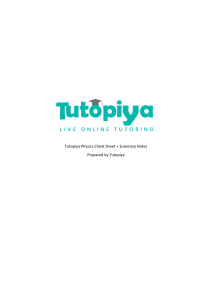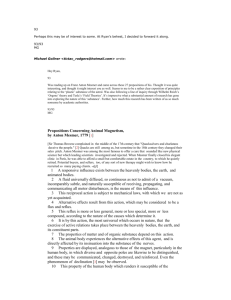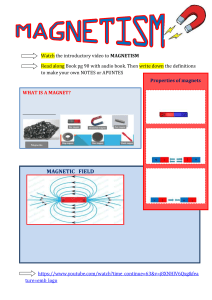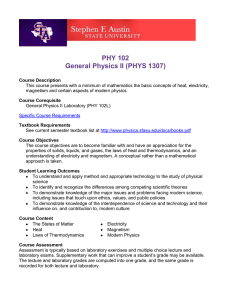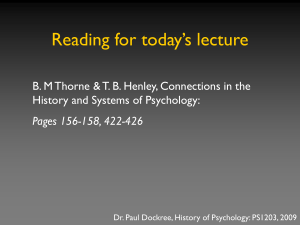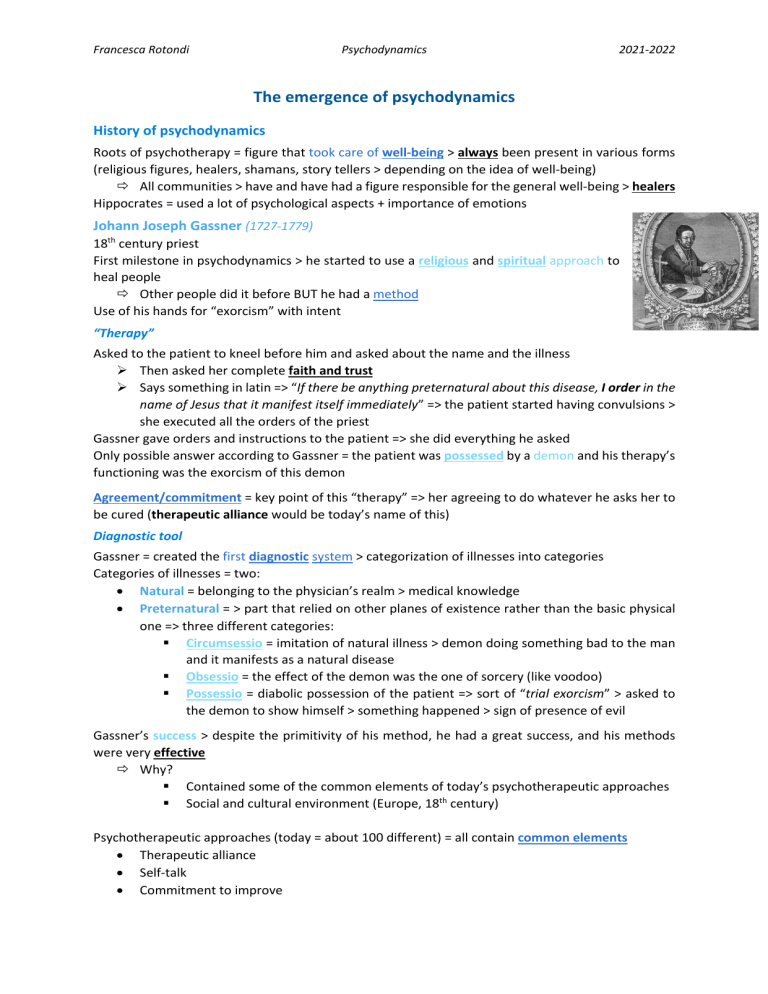
Francesca Rotondi Psychodynamics 2021-2022 The emergence of psychodynamics History of psychodynamics Roots of psychotherapy = figure that took care of well-being > always been present in various forms (religious figures, healers, shamans, story tellers > depending on the idea of well-being) ð All communities > have and have had a figure responsible for the general well-being > healers Hippocrates = used a lot of psychological aspects + importance of emotions Johann Joseph Gassner (1727-1779) 18th century priest First milestone in psychodynamics > he started to use a religious and spiritual approach to heal people ð Other people did it before BUT he had a method Use of his hands for “exorcism” with intent “Therapy” Asked to the patient to kneel before him and asked about the name and the illness Ø Then asked her complete faith and trust Ø Says something in latin => “If there be anything preternatural about this disease, I order in the name of Jesus that it manifest itself immediately” => the patient started having convulsions > she executed all the orders of the priest Gassner gave orders and instructions to the patient => she did everything he asked Only possible answer according to Gassner = the patient was possessed by a demon and his therapy’s functioning was the exorcism of this demon Agreement/commitment = key point of this “therapy” => her agreeing to do whatever he asks her to be cured (therapeutic alliance would be today’s name of this) Diagnostic tool Gassner = created the first diagnostic system > categorization of illnesses into categories Categories of illnesses = two: • Natural = belonging to the physician’s realm > medical knowledge • Preternatural = > part that relied on other planes of existence rather than the basic physical one => three different categories: § Circumsessio = imitation of natural illness > demon doing something bad to the man and it manifests as a natural disease § Obsessio = the effect of the demon was the one of sorcery (like voodoo) § Possessio = diabolic possession of the patient => sort of “trial exorcism” > asked to the demon to show himself > something happened > sign of presence of evil Gassner’s success > despite the primitivity of his method, he had a great success, and his methods were very effective ð Why? § Contained some of the common elements of today’s psychotherapeutic approaches § Social and cultural environment (Europe, 18th century) Psychotherapeutic approaches (today = about 100 different) = all contain common elements • Therapeutic alliance • Self-talk • Commitment to improve Francesca Rotondi Psychodynamics 2021-2022 Gassner’s fading Gassner stopped his work mainly for two reasons: • Critique • Mesmer Critique to Gassner Two main reasons leading the critique: • Envy from priests > it was working all too well > started criticizing Gassner’s work since they were skeptical about him • Wrong timing > Gassner started working when Enlightment started spreading => common point of view wanted reality to be measured, not exorcized Mesmer 1775 = operated like Gassner, but with no religion basis ð He demonstrated he was in charge with no reference to the religious component Gassner left and retired > great shock due to the inexistence of religion in Mesmer’s methods Mesmer > Gassner was right, but had an unnecessary ceremony and used the wrong explanations for the events he caused > he was using “animal magnetism” (Mesmer’s method) without knowing it Ø Too old style (demons and exorcisms) => it’s important not only to cure the sick, but also to cure them with methods accepted by the community Francesca Rotondi Psychodynamics 2021-2022 Franz Anton Mesmer (1734-1815) To “mesmerize” = to amaze, to control = has something to do with hypnosis (still used nowadays) He was probably narcissist > he wanted to be seen as a great healer => wanted to be a healer and did everything he could to be known as the good healer he thought he was Medical studies in Vienna > medical background (thesis = on the influence of planets on human diseases) Own way to interpret pathology (not PSYCHO-pathology) > many studies Interest in magnetism = found out that some English physicians used magnets to heal people (probably not even true) Considered himself as a son of Enlightment => no religious/spiritual elements in his theories (≠ from Gassner) Animal magnetism All people are crossed by an “animal magnetism” = magnetic fluid that streams in all people and can be channeled, stored, and conveyed > some people have more than others Every disease = missing equilibrium in the magnetic flow Ø He only has to re-equilibrate this animal magnetism in others in order to heal them According to Mesmer, the person with the most fluid is not actually himself => it’s Gassner => he simply didn’t know he had it, but he was taking advantage of it without recognizing what it was Ø A way to take advantage of all Gassner’s success to make his theories more believable Mesmer = not interested in using supernatural explanations > he considered himself a component of the Enlightment and reached for a scientific explanation Ø Found similarity between magnetism and electricity (weak spot in his idea) “Therapy” Mesmer made people drink an iron-based drink He then put magnets on specific parts of the body to rebalance the person’s magnetism/magnetic fluid > every person has within itself During this phase > looking in the eyes, knees toughing, sit in front of the patient … He induced a crisis > prescribing the symptoms => he creates a crisis to heal it Ø Slowly, he provoked smaller and smaller attacks > then, the person was healed Castle story = perfect example of how his therapy worked Mesmer arrives at a castle > being close to him = caused in people symptoms (peculiar bodily and physical sensations) He predicted that the baron would be sick the next morning > he actually got sick the morning after Ø Probably these symptoms (pain, sleepiness, gastric-intestinal sensations) have been prompted by a psychological aspect Mesmer’s figure was perceived as overloading charismatic > probably people felt overwhelmed by his presence and symptoms where psychologically created by his presence Ø Perfect example of how the mind has a great influence on our body How could he make these therapy work? => SUGGESTION was the reason why it worked Fräulein Oesterlin One of the first patients of Mesmer’s in Vienna Hysterical patient with some kind of “conversion disorder” > emotions find a way to show themselves in our body Treated to the point she perfectly recovered from her illnesses after this therapy Francesca Rotondi Psychodynamics 2021-2022 Maria-Theresia Paradis Last patient of Mesmer’s in Vienna Daughter of a servant > loss of sight NOT since birth but after Ø At the beginning, the therapy even seemed to work (probably not true) Due to some disagreements between family and Mesmer > he left for Paris Group therapy Great success => the success of therapy lead to a polarization of people => needed to treat more patients at the same time Ø “Group therapy” He restarted in Paris with his treatments > he became very well-known there too > group therapy needed ð Idea of the Baquet > bucket so large that 20 people could sit around it Since magnetism can be channeled, why can’t we channel it through different people at the same time ð Patients tied together Through the motion of his hands, he “connected” and magnetized all of them > convulsion and removal of symptoms Setting = set to help with the involvement in the treatment > music, lighting Sometimes = he used a tree to channel magnetism > mostly for poorer people Société de l’Harmonie Created by Mesmer in order to deliver his therapeutical knowledge to other people Ø Period in which “secret societies” were a thing (18th century) Downfall France > he had a great success => in March 1784, the King appointed two commissions of inquiry Two commissions = made not only of physicians (also Benjamin Franklyn > electricity + chemists, astronomers …) Conclusions of these commissions: • No scientific basis of animal magnetism • Still, they didn’t deny the therapeutic effects of magnetism > ascribed to imagination • King > probably believed that magnetism was helped by the sexual attraction of female patients to the magnetiser Downfall outcome Despite the public discredit > people kept attending the sessions Official science > publicly announced that magnetism wasn’t scientific > why should people keep attending the sessions? Ø Like homeopathy today Human need = to be taken care of => need that also non-scientific therapies can provide ð Some of our actions aren’t based on the motivation we think that fuels them ð I go to the physician for a headache > maybe I just need to be listened to Mesmer = left no room for change or interpretations of his legacy Francesca Rotondi Psychodynamics 2021-2022 Ø Asked for deep devotion from his students and didn’t allow them do develop anything different from his therapy and ideas Newspaper > started mocking Mesmer => from a guru, he became a joke ð Left Paris Mesmer’s legacy More a magician than a psychotherapist BUT > important discoveries about human mind: • To make a meaningful change through therapy > need for a relationship with the patient => need to “tune in” with the patient • Facing crises > active ingredient in treatments (catharsis > by facing the crisis, I bring out my emotions and give them a name) Francesca Rotondi Psychodynamics 2021-2022 Marquis de Puysegur (1751-1825) Mesmer = initiator of magnetism Peysegur = founder of magnetism Found some of Mesmer’s findings on magnetism > studied magnetism and entered the “Société de l’harmonie” Therapy Magnetisation > brought his patients to a trance state Crisis: • Looks like a trance > strange sleep • More aware and awake that in his normal condition > could even answer questions • After the crisis > no memory of the crisis and the happenings ð After asking them questions > they were able to diagnose their own diseases, foresee the course of its evolution, and prescribe treatments Collective treatments Around the tree close to his family castle First step = magnetization of patients > they remained in a trance for the whole time Ø Patients are tied together are to the tree Ø Then, they are “unchained” and asked to rub their hands After being unchained, some of the patients were chosen to be the physicians => asked them to diagnose other people’s diseases and find a cure for them At the end > to wake them all up he made them kiss the tree The perfect crisis Puysegur > aimed at causing the perfect crisis in his patients • Appearance of a waking state • Elective relationship with the magnetizer > subjects needed to execute all his commands • Subsequent amnesia “Artificial somnambulism” > phenomena usually associated with a wake state happening in sleep ð Later labelled by Braid as “hypnosis” Victor Race One of Puysegur’s first patients Ø Victor was easily magnetisable > “peculiar crisis” Great pride of Victor > he brought him in Paris and showed everyone how he “hypnotized” (he wouldn’t call it that) him Victor = got worse > Puysegur explained it as him not liking his treatment ð At the end > he understood that patients shouldn’t be used as a means to do business Strasbourg In Strasbourg > Puysegur organized the “Société Harmonique des Amis Réunis” Purpose = to explore more in deep the potentials of this treatment > they provided it for free French Revolution (1789) > spent two years in prison, but managed to recover his castle Ø New generations of magnetizers > started considering Peysegur as the founder of magnetism Francesca Rotondi Psychodynamics 2021-2022 1818 > Victor Race got severely ill Ø Magnetised him again in the same setting of the first time Puysegur realized that, when Victor was magnetised, he could remember details from his previous magnetizations ð Deep hypnosis/trance state = creates memories that can be accessed only when in that stage Diffusion of Mesmerism Puysegur started writing books on magnetism > his and Mesmer’s were considered the great books on magnetism for at least one generation France = scientists and physicians never supported magnetism => it limited the diffusion of mesmerism Abbé Faria Portuguese priest that got interested in magnetism He asked his patients to stare at his hand > after a while, he said “sleep!” => patients started sleeping End of his career > an actor started joking about him > he retired Germanic countries Great impact of Mesmerism on Germanic countries > university in Berlin = had chairs of mesmerism Ø Romanticism approach > great similarity to mesmerism > idea of one thing that unites all humans BUT > arrival of Positivism => mesmerism didn’t last too long Carl Kluge – six degrees of magnetic state 1. 2. 3. 4. 5. Waking state > increased sensation of warmth Half-sleep Inner darkness > proper sleep and insensitivity Inner clarity > consciousness and extrasensory perception Self-contemplation > ability to perceive the interior of his own body and of those he was asked to look into 6. Universal clarity > removal of veils of time => perception of things hidden in past/present/distant future Last three = almost never shown, especially the last one USA USA = from mesmerism to spiritism => artificial somnambulism for medium to get in contact with the dead Ø Spiritism = gave new approaches to today’s psychology and dynamic psychiatry (for example, automatic writing) Francesca Rotondi Psychodynamics 2021-2022 Hypnosis Two approaches to hypnosis: • Spectacular performances in theatres to show their abilities > no medical or therapeutic element in it • New interest in hypnosis > two schools Nancy school 1860 to 1880 > discrediting of magnetism and hypnosis ð Physicians who used it were discredited as such Auguste Ambroise Liebeault – 1823-1904 Founded the Nancy school Medical student > found an old book about magnetism => started proposing these treatments to some of his patients for free ð Large number of patients who came to him to be magnetized Asked patients to look at him in his eyes > started suggesting they were getting sleepy Ø The patient started getting hypnotized > he told them they were being relieved of their symptoms Considered both a quack and a fool > until Bernheim paid him a visit Bernheim – 1840-1919 Hypnosis > could work better with some patients rather than other Ø Hypnosis is a way to distract the patient from reality > works best with ex-soldiers or factory workers Suggestibility = the aptitude to transform an idea into an act With time > understood that the important part about suggestion wasn’t hypnosis (started eliminating it from his sessions) ð He understood that they could be provided in a waking state too Great success > Sigmund Freud spent some weeks learning from him in Nancy school Considered the foremost psychotherapist > later forgotten Salpetriere school Strong organization > more known and recognized than Nancy school Powerful central figure = Charcot Charcot – 1835-1893 Neurologist > study of mental diseases Started studying hypnosis scientifically > female hysterical patients Freud = spent a whole semester studying in this school Ø The concept of hypnosis was re-evaluated thanks to his studies on it “A prince de la science” He is seen as a precursor of Freud’s
